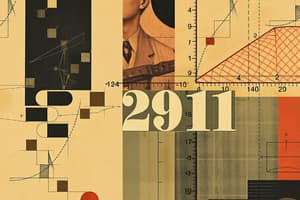Podcast
Questions and Answers
What are sequences investigated with?
What are sequences investigated with?
- Numbers
- Rules
- Patterns
- Patterns and rules (correct)
Sequence inputs/n-values can only be?
Sequence inputs/n-values can only be?
0 or positive integers
What are arithmetic sequences?
What are arithmetic sequences?
Sequences generated by adding a constant to the previous term.
What are geometric sequences?
What are geometric sequences?
In sequence equations, what is 'n'?
In sequence equations, what is 'n'?
What symbols are used to write sequence equations?
What symbols are used to write sequence equations?
What is t(0)?
What is t(0)?
What is t(1)?
What is t(1)?
What is the growth rate/common difference (d) of arithmetic sequences?
What is the growth rate/common difference (d) of arithmetic sequences?
What type of graph do linear functions produce?
What type of graph do linear functions produce?
What type of graph do arithmetic sequences produce?
What type of graph do arithmetic sequences produce?
What is the explicit equation for arithmetic sequences?
What is the explicit equation for arithmetic sequences?
What is the explicit equation for the arithmetic sequence -5, -3, -1, 1, 3?
What is the explicit equation for the arithmetic sequence -5, -3, -1, 1, 3?
What is the recursive equation for arithmetic sequences?
What is the recursive equation for arithmetic sequences?
What is the recursive equation for the arithmetic sequence 8, 5, 2, -1, -4?
What is the recursive equation for the arithmetic sequence 8, 5, 2, -1, -4?
For recursive equations, what is needed?
For recursive equations, what is needed?
What is the representation of a recursive equation for an arithmetic sequence?
What is the representation of a recursive equation for an arithmetic sequence?
What is the multiplier/common ratio (r) of geometric sequences?
What is the multiplier/common ratio (r) of geometric sequences?
What type of graph do geometric sequences produce?
What type of graph do geometric sequences produce?
What is the explicit equation for geometric sequences?
What is the explicit equation for geometric sequences?
What is the explicit equation for the geometric sequence 8, 32, 128, 512, 2048?
What is the explicit equation for the geometric sequence 8, 32, 128, 512, 2048?
What is the recursive equation for geometric sequences?
What is the recursive equation for geometric sequences?
What is the recursive equation for the geometric sequence 8, 32, 128, 512, 2048?
What is the recursive equation for the geometric sequence 8, 32, 128, 512, 2048?
Flashcards are hidden until you start studying
Study Notes
General Concepts
- SEQUENCES consist of patterns and rules governing the arrangement of numbers.
- Sequence inputs, or n-values, are restricted to non-negative integers.
Types of Sequences
- Arithmetic Sequences: Created by adding a constant value (common difference) to the previous term.
- Geometric Sequences: Formed by multiplying the previous term by a constant value (common ratio).
Sequence Variables and Terms
- In sequence equations, "n" refers to the position of a term in the sequence.
- Different notations used for sequences include t(n), tn, t, a(n), t(n+1), and t(n-1).
- t(0) identifies the 0th term, while t(1) refers to the 1st term.
Arithmetic Sequences
- The GROWTH RATE or COMMON DIFFERENCE (d) in arithmetic sequences is constant and analogous to the slope of the line.
- GRAPHS of arithmetic sequences depict a straight line but are discrete (not continuous).
- Explicit Equation: For arithmetic sequences, the formula is t(n) = d(n) + t(0).
- Example Explicit Equation: For the sequence -5, -3, -1, 1, 3, it is expressed as t(n) = 2(n) - 7.
- Recursive Equation: Defined as t(n+1) = t(n) + d, requiring an initial term such as t(0) or t(1).
Geometric Sequences
- The MULTIPLIER or COMMON RATIO (r) signifies the factor by which each term is multiplied to obtain the next term.
- GRAPHS of geometric sequences illustrate a curved exponential line and are also discrete.
- Explicit Equation: For geometric sequences, the equation is t(n) = t(0) (r)ⁿ.
- Example Explicit Equation: For the sequence 8, 32, 128, 512, 2048, the equation is t(n) = 2(4)ⁿ.
- Recursive Equation: Expressed as t(n+1) = r * t(n), necessitating initial terms t(0) and t(1).
Examples of Sequences
- Arithmetic Recursive Equation for 8, 5, 2, -1, -4: t(n+1) = t(n) - 3 with d = -3, starting from t(1) = 8.
- Geometric Recursive Equation for 8, 32, 128, 512, 2048: t(n+1) = 4 * t(n) with t(0) = 2 and t(1) = 8.
Studying That Suits You
Use AI to generate personalized quizzes and flashcards to suit your learning preferences.




